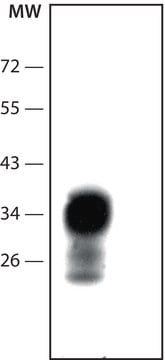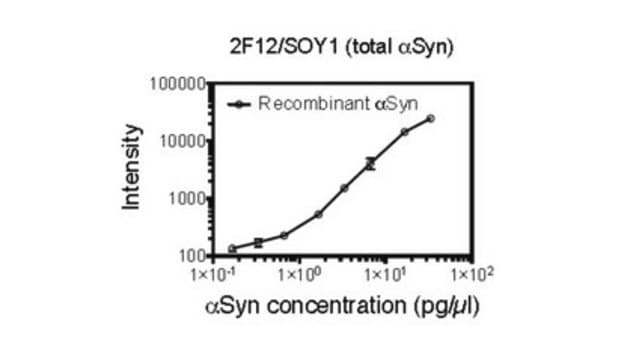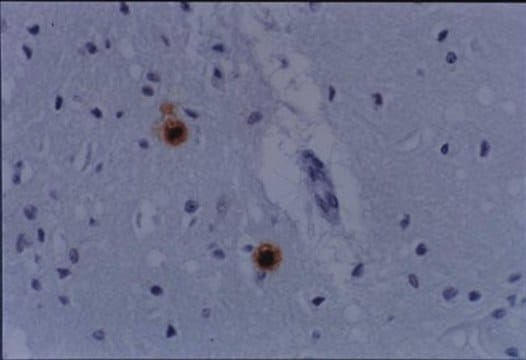一般說明
We are committed to bringing you greener alternative products, which adhere to one or more of The 12 Principles of Green Chemistry.This antibody is Preservative-free, produced without the harm or sacrifice of animals and exceptionally stable to allow for ambient shipping and storage if needed and thus aligns with "Waste Prevention", "Designing Safer Chemicals" and "Design for Energy Efficiency".
Click here for more information.
ZooMAb
® antibodies represent an entirely new generation of recombinant monoclonal antibodies.
Each ZooMAb
® antibody is manufactured using our proprietary recombinant expression system, purified to homogeneity, and precisely dispensed to produce robust and highly reproducible lot-to-lot consistency. Only top-performing clones are released for use by researchers. Each antibody is validated for high specificity and affinity across multiple applications, including its most commonly used application. ZooMAb
® antibodies are reliably available and ready to ship when you need them.
Learn more about ZooMAb here.特異性
Clone 3F17 is a ZooMAb® rabbit recombinant monoclonal antibody that specifically detect Prion protein.
免疫原
KLH-conjugated linear peptide corresponding to 19 amino acids from the N-terminal half of human prion protein.
應用
Quality Control Testing
Evaluated by Western Blotting in Mouse brain tissue lysate.
Western Blotting Analysis: A 1:1,000 dilution of this antibody detected Prion Protein in Mouse brain tissue lysate.
Tested applications
Immunohistochemistry (Paraffin) Analysis: A 1:1,000 dilution from a representative lot detected Prion Protein in human cerebral cortex and human Alzheimer′s diseased brain tissue sections.
Immunocytochemistry Analysis: A 1:1000 dilution from a representative lot detected Prion Protein in SH-SY5Y cells.
Affinity Binding Assay: A representative lot of this antibody bound Prion Protein peptide with a KD of 1.0 x 10-12 in an affinity binding assay.
Flow Cytometry Analysis: 1 μg from a representative lot detected Prion Protein in one million SH-SY5Y cells.
Note: Actual optimal working dilutions must be determined by end user as specimens, and experimental conditions may vary with the end user
Anti-Prion Protein, clone 3F17 ZooMAb®, Cat. No. ZRB1924, is a recombinant Rabbit monoclonal antibody that targets Prion Protein and is tested in Affinity Binding Assay, Flow Cytometry, Immunocytochemistry, Immunohistochemistry, and Western Blotting.
標靶描述
Major prion protein (UniProt: P04156; also known as PrP, ASCR, PrP27-30, PrP33-35C, CD230) is encoded by the PRNP (also known as ALTPRP, PRIP, PRP) gene (Gene ID: 5621) in human. PrP is highly expressed in the brain, lung, kidney and heart and low levels of expression are reported in the liver and spleen. It is found in high quantity in the brain of humans and animals infected with degenerative neurological diseases such as Kuru, Creutzfeldt-Jakob disease (CJD), Gerstmann-Straussler syndrome (GSS), scrapie, bovine spongiform encephalopathy (BSE), and transmissible mink encephalopathy (TME). In normal brain it may play a role in neuronal development and synaptic plasticity and may be required for neuronal myelin sheath maintenance and myelin homeostasis by acting as an agonist for ADGRG6 receptor. PrP can exist in either PrPc (c = cellular) or PrPsc (sc = Scrapie) form. PrPc is a glycoprotein normally found inserted in the plasma membrane by a glycosyl phosphatidylinositol (GPI) anchor and can be easily digested by proteases. It is composed mainly of a-helices. The PrPsc has more of a b-sheet type structure and is highly resistant to the action of proteases. The prion proteins possess two N-linked glycosylation sites and may contain over 50 different sugars. The large size of the N-linked sugars enables them to shield two orthogonal faces of the protein almost completely and protect large regions of the protein surface from proteases. The PrPsc is shown to contain the same set of glycans as PrPc but has a higher proportion of tri- and tetra-antennary sugars. It is shown that following proteinase K treatment, PrPc is completely digested, whereas PrPsc is only shortened to a 27-30 kDa fragment. This ZooMAb® recombinant monoclonal antibody, generated by our propriety technology, offers significantly enhanced specificity, affinity, reproducibility, and stability over conventional monoclonals.
外觀
Purified recombinant rabbit monoclonal antibody IgG, lyophilized in PBS with 5% Trehalose, normal appearance a coarse or translucent resin. The PBS/trehalose components in the ZooMAb formulation can have the appearance of a semi-solid (bead like gel) after lyophilization. This is a normal phenomenon. Please follow the recommended reconstitution procedure in the data sheet to dissolve the semi-solid, bead-like, gel-appearing material. The resulting antibody solution is completely stable and functional as proven by full functional testing. Contains no biocide or preservatives, such as azide, or any animal by-products. Larger pack sizes provided as multiples of 25 μL.
重構
300 μg/mL after reconstitution at 25 μL per vial. Please refer to guidance on suggested starting dilutions and/or titers per application and sample type.
儲存和穩定性
Recommend storage of lyophilized product at 2-8°C; Before reconstitution, micro-centrifuge vials briefly to spin down material to bottom of the vial; Reconstitute each vial by adding 25 μL of filtered lab grade water or PBS; Reconstituted antibodies can be stored at 2-8°C, or -20°C for long term storage. Avoid repeated freeze-thaws.
法律資訊
ZooMAb is a registered trademark of Merck KGaA, Darmstadt, Germany
免責聲明
Unless otherwise stated in our catalog or other company documentation accompanying the product(s), our products are intended for research use only and are not to be used for any other purpose, which includes but is not limited to, unauthorized commercial uses, in vitro diagnostic uses, ex vivo or in vivo therapeutic uses or any type of consumption or application to humans or animals.










